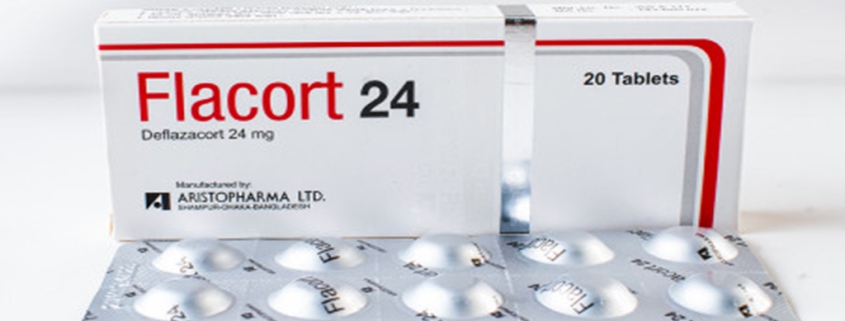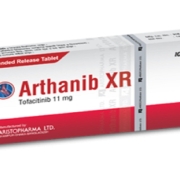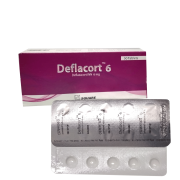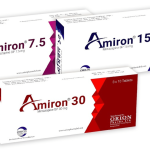Flacort (Deflazacort)
Description
Deflazacort provides anti-inflammatory action by inhibiting Phospholipase A2 enzymeWhich is responsible for prostaglandin synthesis. Besides Deflazacort decreases the release of certain chemicals that are important in the immune system. By decreasing the release of these chemicals Deflazacort provides immunosuppressive action.
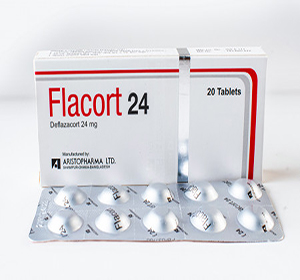
Presentation
Flacort Tablet: Each tablet contains Deflazacort INN 6 mg.
Flacort 24 Tablet: Each tablet contains Deflazacort INN 24 mg.
Flacort Suspension: Each 5 ml suspension contains Deflazacort INN 6 mg.
Indications
- Anaphylaxis, asthma, severe hypersensitivity reactions
- Rheumatoid arthritis, juvenile chronic arthritis, polymyalgia rheumatica
- Systemic lupus erythematosus, dermatomyositis, mixed connective tissue disease (other than systemic sclerosis), polyarteritis nodosa, sarcoidosis
- Pemphigus, bullous pemphigoid, pyoderma gangrenosum
- Idiopathic nephrotic syndrome, acute interstitial nephritis
- Rheumatic carditis
- Ulcerative colitis, Crohn’s disease
- Uveitis, optic neuritis
- Autoimmune haemolytic anaemia, idiopathic thrombocytopenic purpura
- Acute and lymphatic leukaemia, malignant lymphoma, multiple myeloma
- Immune suppression in transplantation
- Drug resistant epilepsy
- Duchenne muscular dystrophy
Dosage & Administration
Adults:
For acute disorders, up to 120 mg/day Deflazacort may need to be given initially. Maintenance doses in most conditions are within the range 3-18 mg/day. The following regimens are for guidance only.
Rheumatoid arthritis: The maintenance dose is usually within the range 3-18 mg/day. The smallest effective dose should be used and increased if necessary.
Bronchial asthma: In the treatment of an acute attack, high doses of 48-72 mg/day may be needed depending on severity and gradually reduced once the attack has been controlled. For maintenance in chronic asthma, doses should be titrated to the lowest dose that controls symptoms.
Other conditions: The dose of Deflazacort depends on clinical need titrated to the lowest effective dose for maintenance. Starting doses may be estimated on the basis of ratio of 5 mg prednisone or prednisolone to 6 mg Deflazacort.
Children:
In children, the indications for Deflazacort are the same as for adults, but it is important that the lowest effective dosage is used. Alternate day administration may be appropriate.
Doses of Deflazacort usually lie in the range 0.25-1.5 mg/kg/day. The following ranges provide general guidance:
Juvenile chronic arthritis: The usual maintenance dose is between 0.25-1.0 mg/kg/day. Nephrotic syndrome: Initial dose of usually 1.5 mg/kg/day followed by down titration according to clinical need.
Bronchial asthma: The initial dose should be between 0.25-1.0 mg/kg on alternate days.
Deflazacort withdrawal:
In patients who have received more than physiological doses of systemic corticosteroids (approximately 9 mg per day or equivalent) for greater than 3 weeks, withdrawal should not be abrupt. How dose reduction should be carried out depends largely on whether the disease is likely to relapse as the dose of systemic corticosteroids is reduced.
Contrainidications
- Hypersensitivity to Deflazacort or any of the ingredients.
- Patients receiving live virus immunization.
Warning & Precautions
The following clinical conditions require special caution and frequent patient monitoring is necessary:
- Cardiac disease or congestive heart failure (except in the presence of active rheumatic carditis), hypertension, thromboembolic disorders.
- Gastritis or oesophagitis, diverticulitis, ulcerative colitis if there is probability of impending perforation, abscess or pyogenic infections, fresh intestinal anastomosis, active or latent peptic ulcer.
- Diabetes mellitus or a family history, osteoporosis, myasthenia gravis.
- Emotional instability or psychotic tendency.
- Previous corticosteroid induced myopathy.
- Hypothyroidism and cirrhosis, which may increase glucocorticoid effect.
- Ocular herpes simplex because of possible corneal perforation.
Side effects
After administration occasionally GI disturbances like dyspepsia, nausea; musculoskeletal disorders like myopathy; depressed mood, skin atrophy, acne etc. may occur.
Drug interaction
Deflazacort is metabolized in the liver. It is recommended to increase the maintenance dose of Deflazacort if drugs which are liver enzyme inducers are co-administered, e.g. rifampicin, rifabutin, carbamazepine, phenobarbitone, phenytoin, primidone and aminoglutethimide. For drugs which inhibit liver enzymes, (e.g. ketoconazole) it may be possible to reduce the maintenance dose of Deflazacort.
Use in special groups
Use in pregnancy: Deflazacort does cross the placenta. When administered for prolonged periods or repeatedly during pregnancy, corticosteroids may increase the risk of intra-uterine growth retardation. As with all drugs, corticosteroids should only be prescribed when the benefits to the mother and child outweigh the risks.
Use in lactation: Corticosteroids are excreted in breast milk. Doses up to 50 mg daily of Deflazacort are unlikely to cause systemic effects in the infant.
Hepatic impairment: In patients with hepatic impairment, blood levels of Deflazacort may be increased. Therefore the dose of Deflazacort should be carefully monitored and adjusted to the minimum effective dose.
Renal impairment: In renal impaired patients, no special precautions other than those usually adopted in patients receiving glucocorticoid therapy are necessary.
Elderly: In elderly patients, no special precautions other than those usually adopted in patients receiving glucocorticoid therapy are necessary.
Packing
Flacort Tablet: Each box contains 30 tablets in alu-alu blister pack.
Flacort 24 Tablet: Each box contains 20 tablets in alu-alu blister pack.
Flacort Suspension: Each bottle contains 60 ml oral suspension.

